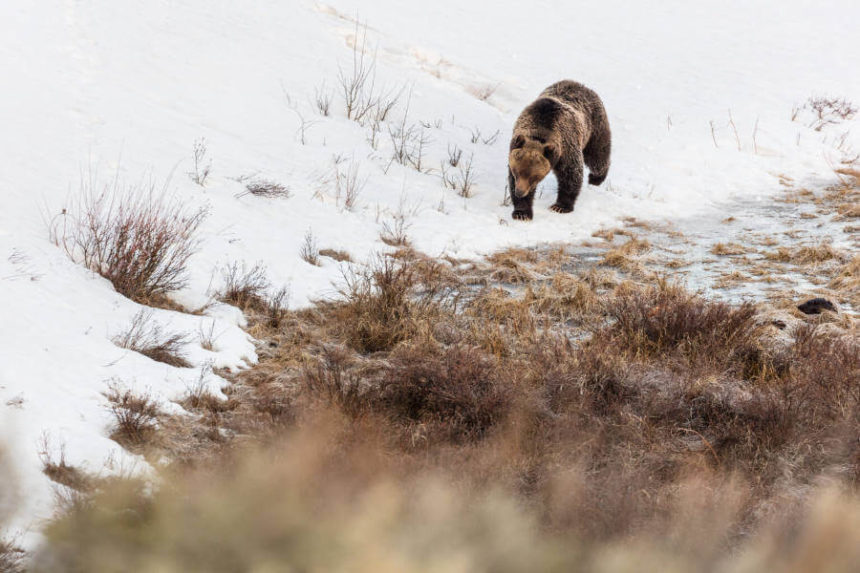Sen. Risch introduces bill to fully delist grizzly bears in lower 48
Published at | Updated at
U.S. Sen. Jim Risch has introduced a bill in the U.S. Senate that would fully delist grizzly bears in the lower 48 from Endangered Species Act protections.
Risch, R-Idaho, introduced S. 2571, the Grizzly Bear Review and Resource Act, on July 27, shortly before Congress went on its summer recess.
U.S. Sens. Mike Crapo, R-Idaho, and Cynthia Lummis, R-Wyoming, co-sponsored the bill while U.S. Rep. Russ Fulcher, R-Idaho, signaled his support in the U.S. House of Representatives.
In 1975, grizzly bears in the lower 48 were listed as a threatened species under the Endangered Species Act. The listing required recovering the species to a self-sustaining population, and it became illegal to kill, harass or harm grizzlies except in self-defense.

The U.S. Fish and Wildlife Service removed grizzly bears from the threatened species list in 2007 and 2017, but district judges reinstated grizzlies in 2009 and 2018.
Risch said it is time to remove grizzly bears from the list of threatened species because grizzly bear numbers are up and the bears are coming into conflict with humans and livestock.
“It is clear grizzly populations have rebounded,” Risch said in a written statement. “Increasing grizzly bear and human encounters make it even more important to act now. The ‘Grrr Act’ will take much-needed action to delist grizzly bears and focus resources on animals that are truly endangered or at risk.”
Conservationists say grizzly bears still need protection in Idaho
Meanwhile, a wildlife program associate with the Idaho Conservation League expressed several concerns about Risch’s bill. Jeff Abrams said grizzly populations have not recovered in the Selkirk Range that includes North Idaho and parts of southeastern Washington, the Bitterroot Range of central Idaho and western Montana, and the Cabinet-Yaak Ecosystem that includes parts of North Idaho and northwestern Montana.
“Populations in the Selkirks, the Bitterroot Range and Cabinet-Yaak aren’t recovered and shouldn’t be delisted until the agreed-upon recovery goals have been met,” Abrams said in a telephone interview.
“(The Idaho Conservation League) is generally uncomfortable with the idea of legislative solutions to wildlife management because they don’t tend to be tethered to scientific evidence. Those approaches have historically not turned out well,” Abrams added.
Without the protections put in place through the Endangered Species Act, Abrams said the Idaho Conservation League believes the grizzly bear would be extinct in the lower 48.
According to the U.S. Fish and Wildlife Service, there were an estimated 50,000 grizzly bears living in 18 states in the West prior to 1800. But those numbers were reduced down to 700 or 800 bears by 1975 due to government bounty programs, hunting, trapping and poisoning alongside the exploration and development of the American West.
Recent estimates from the U.S. Fish and Wildlife Service indicate there are at least 1,923 grizzly bears across the lower 48, with most in the North Continental Divide Ecosystem of north-central Montana (1,092) and the Greater Yellowstone Ecosystem (727).
Along with Risch, U.S. Sen. Mike Crapo supports fully delisting grizzly bears
In a written statement, Crapo voiced support for having the state take over management of grizzly bears from the federal government.
“Idaho’s wildlife is best managed at the local level through collaborative efforts among federal, state and tribal entities,” Crapo wrote. “The grizzly’s current ESA status rejects the reality of the recovered population within the grizzly’s historic range and ignores current management practices backed by science and common sense.”
But Abrams, from the Idaho Conservation League, said Idaho Fish and Game and the state government should first prove they are ready to responsibly take over management of grizzly bears.
“Let’s talk about what the Idaho Department of Fish and Game’s grizzly management plan would look like right now, if they weren’t listed,” Abrams said. “In other words, are they doing the things they need to do to credibly take responsibility for management of grizzly bears? Many of the basic elements have not been put into place yet.”
Many of the elements Abrams believe should be in place include a conservation strategy, the use of nonlethal deterrent programs, plans for dealing with conflicts between bears, humans, livestock producers and land managers and plans and regulations for hunting and trapping.
Risch’s bill is one of several recent bills that would delist grizzly bears in some form or another. In February, Risch and Crapo joined Lummis as cosponsors of S.445, the Grizzly Bear State Management Act of 2023, which would have removed grizzly bears specifically in the Greater Yellowstone Ecosystem from the threatened species list. That bill has so far not advanced after being referred to the Senate Committee on Environment and Public Works
There are other efforts too. H.R. 1245, is a bill in the U.S. House of Representatives that would delist grizzly bears in the Greater Yellowstone Ecosystem. And last month, U.S. Rep. Ryan Zinke, R-Montana, secured an amendment to a federal spending bill that would delist grizzly bears in the Greater Yellowstone Ecosystem, the Billings Gazette reported.
A Yellowstone National Park spokeswoman referred questions about how Risch’s bill would affect bears in Yellowstone National Park to a spokesman for the U.S. Fish and Wildlife Service, who declined to comment on pending legislation in Congress.



